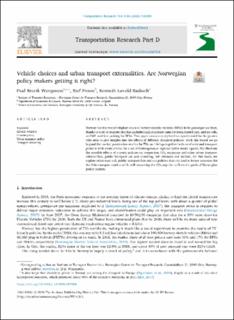| dc.contributor.author | Wangsness, Paal Brevik | |
| dc.contributor.author | Proost, Stef | |
| dc.contributor.author | Rødseth, Kenneth Løvold | |
| dc.coverage.spatial | Norway, Oslo | en_US |
| dc.date.accessioned | 2021-01-14T13:11:41Z | |
| dc.date.available | 2021-01-14T13:11:41Z | |
| dc.date.created | 2020-07-06T15:08:18Z | |
| dc.date.issued | 2020-06-15 | |
| dc.identifier.citation | Transportation Research Part D: Transport and Environment. 2020, 86 . | en_US |
| dc.identifier.issn | 1361-9209 | |
| dc.identifier.uri | https://hdl.handle.net/11250/2723108 | |
| dc.description.abstract | Norway has the world’s highest share of battery electric vehicles (BEVs) in its passenger car fleet, thanks to a set of policies that has included high purchase taxes for fossil fueled cars, and no tolls, no VAT, and free parking for BEVs. This paper uses a very stylized transport model for the greater Oslo area to give insights into the effects of different transport policies. With this model we go beyond the market penetration studies for EVs, as it brings together both car choice and transport patterns with mode choice for a set of heterogeneous representative model agents. We illustrate the possible effects of current policies on congestion, CO2 emissions and other urban transport externalities, public transport use and crowding, tax revenues and welfare. On this basis, we explore other road toll, public transport fare and tax policies that can lead to better outcomes for the Oslo transport market while still respecting the CO2-cap that reflects the goals of Norwegian policy makers. | en_US |
| dc.language.iso | eng | en_US |
| dc.publisher | Elsevier | en_US |
| dc.rights | Navngivelse 4.0 Internasjonal | * |
| dc.rights.uri | http://creativecommons.org/licenses/by/4.0/deed.no | * |
| dc.title | Vehicle choices and urban transport externalities. Are Norwegian policy makers getting it right? | en_US |
| dc.type | Journal article | en_US |
| dc.type | Peer reviewed | en_US |
| dc.rights.holder | © 2020 The Authors. Published by Elsevier Ltd. | en_US |
| dc.description.version | publishedVersion | en_US |
| cristin.ispublished | true | |
| cristin.fulltext | original | |
| cristin.qualitycode | 2 | |
| dc.identifier.doi | https://doi.org/10.1016/j.trd.2020.102384 | |
| dc.identifier.cristin | 1818731 | |
| dc.source.journal | Transportation Research Part D: Transport and Environment | en_US |
| dc.source.volume | 86 | en_US |
| dc.source.issue | September | en_US |
| dc.source.pagenumber | 21 | en_US |
| dc.relation.project | Norges forskningsråd: 255077 | en_US |

